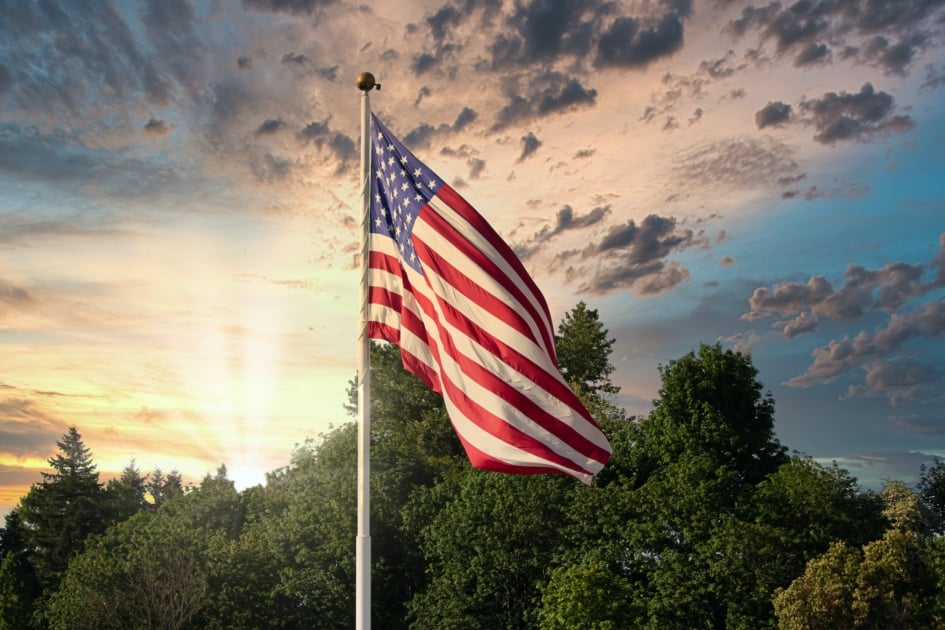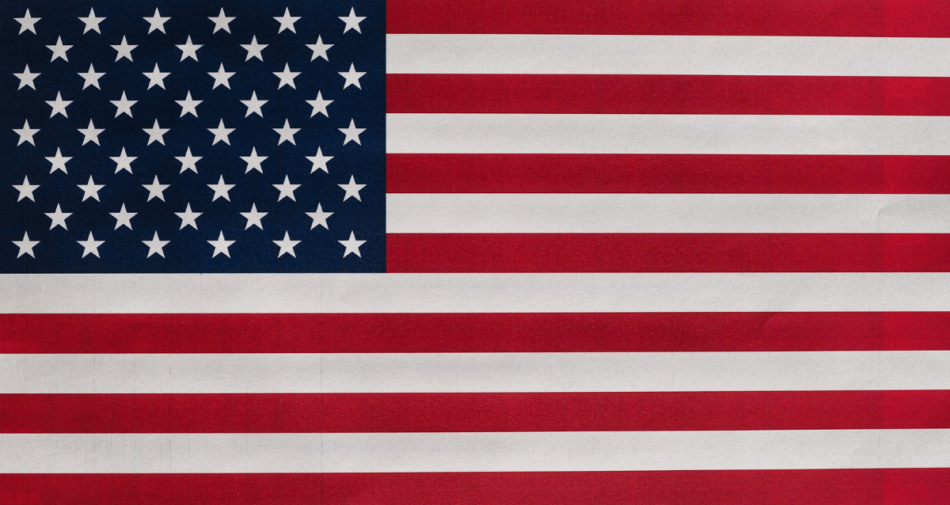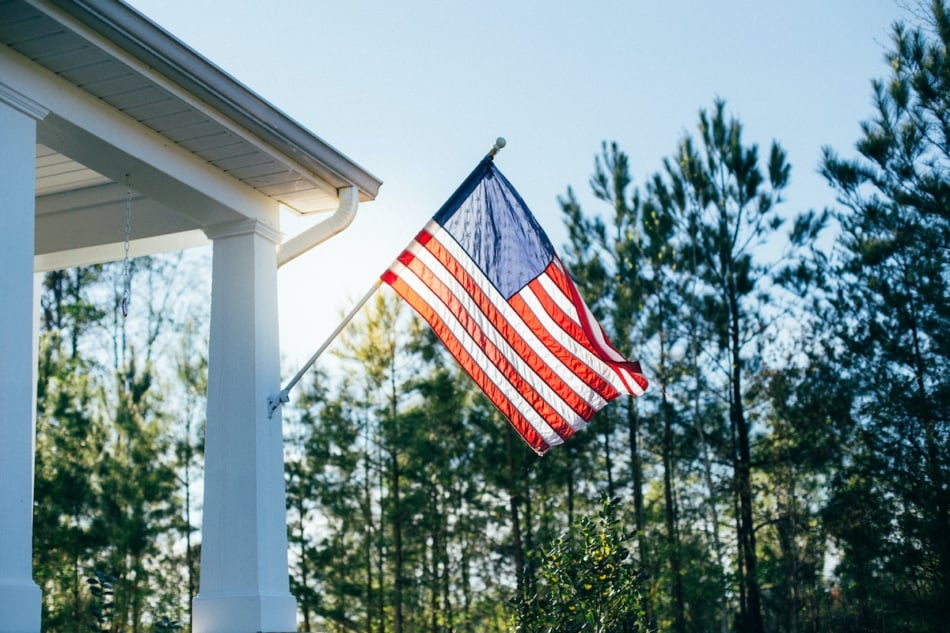American Flag Rules & Etiquette
Learn all the parts of the American flag, how and when to properly display it, as well as other important guidelines.

Whether you call it Old Glory, the Stars and Stripes, or the Star-Spangled Banner, most of the rules, customs, and traditions governing the display of the American Flag come from a law called the US Flag Code (United States Code Title 4, Chapter 1).
The military strictly adheres to the Flag Code, so if you have any questions about the proper way to treat or display the flag, it’s a foregone conclusion that any active or retired serviceperson you may know is going to have the answers. However, here is an overview of some of the main points of the flag code as a reference.
Two Parts Of The Flag
1) The Union
The Union is the blue field on the flag, which today contains 50 white stars. Each star symbolically represents one of the United States. But no one star by location or position in the union represents any specific state. In the event a new state is added, the flag is changed with the addition of a new star, always on July 4th.
The current 50-star flag has been in use since July 4, 1960, after Hawaii was admitted as the 50th state on August 21st, 1959.

2) The Stripes
Thirteen horizontal stripes alternating red and white, adorn the flag. These represent the original 13 colonies that declared independence from Great Britain in 1776. A red stripe appears at the very top of the flag, and at the very bottom as well. Seven red stripes and six white stripes also help us remember the year of our founding (“76”).
Respect For The Flag
The flag of the United States should always be treated with deference, respect, and reverence. The Flag Code has many rules for the display of the flag, and most of these are common sense based on the idea that our flag should be given the prominence of honor when displayed with other flags or banners.
The flag represents a living country and good etiquette results from treating the symbol as if it were a living thing, representing the freedoms and ideals that founded our nation which we continue to hold dear.
Allowing the flag to become damaged or neglected or inappropriately handled is a sign of disrespect. Therefore, citizens should stand at attention and salute when their flag is passing in a parade or being hoisted or lowered.
Some Flag Don’ts:
- The flag of the United States of America should never be dipped to any person or thing. It should not be carried flat or horizontally. Regimental colors, State flags, and organizational or institutional flags or banners may be dipped as a sign of honor, but not the American flag.
- The flag should never be displayed with the Union down, except as a signal of dire distress in instances of extreme danger to life and property.
- The flag should never touch the ground or anything beneath it.
- The flag should never be fastened, displayed, used, or stored in such a way to permit it to be easily torn, soiled, or damaged in any way.
- The flag should never be used as wearing apparel, bedding, or drapery. It should never be festooned, drawn back, nor up, in folds, but always allowed to fall free.
- The flag should never be marked up or written on in any way, not embroidered on articles like cushions to sit on, or handkerchiefs, or printed on anything that is disposable, such as paper plates or napkins.
- No part of the flag should ever be used as a costume or athletic uniform, though a flag patch may be affixed to the uniform of military personnel, firemen, policemen, and members of patriotic organizations. A flag lapel pin is somewhat a special case, it is technically considered a replica of the flag, and should be worn on the left lapel, near the heart.
How To Properly Display The Flag
- The most common way to display a flag is on a flagpole or staff. The flag should always be hoisted briskly and lowered ceremoniously. It’s customary to fly the flag from sunrise to sunset, and not in inclement weather. But all-weather flags are available; and if the flag is illuminated appropriately, it may be displayed at night for a patriotic effect.
- No other flag or banner should be flown on a flagpole above the United States flag. (The one exception is a church pennant, which may be flown on a ship during church services by naval chaplains at sea for the personnel of the navy). In all situations, the flag of the United States of America should have a position of greatest honor when displayed with other flags or banners; for example, at the center or highest group when a number of flags of States or localities or pennants of societies are grouped and displayed from staffs. If displayed with another flag against a wall from crossed staffs, the flag of the United States should be on the right (the flag’s own right), and its staff should be in front of the other flag.
- When displayed horizontally or vertically against a wall, the union should be uppermost and to the flag’s own right, that is the observer’s left. A good rule of thumb is, just as we read from left to right, the static displayed flag should always be “read” by the viewer from left to right, with the union first. The exceptions to this rule are when a flag is seen as moving forward in a procession or battle, or even on a vehicle. Even though the union may appear to the viewer’s right, the sense is that the flag in motion is waving free with the blue field of the union still leading the way. On flag shoulder patches on military uniforms, the flag may seem “backward” to some, but it’s done so to represent the flag moving forward into battle, union first (on the flag’s own right), and stripes trailing. Another way to look at it is that on the right shoulder sleeve of a military uniform, the viewer is seeing the reverse side of the flag.
- When the flag of the United States of America is displayed on a motorcar, the staff shall be affixed firmly to the chassis or clamped to the right fender.
- When the flag is used to cover a casket, it should be so placed that the union is at the head and over the left shoulder. The flag should not be lowered into the grave or allowed to touch the ground.
- When the flag of the United States is to be shown at half-staff, it should be hoisted to the top of the staff first, then ceremoniously lowered to half-staff.
- When displayed over a street, it should be suspended vertically with the union to the north in an east and west street, or to the east in a north and south street.
- On a platform, it should be above and behind the speaker, with the union uppermost and to the observer’s left.
- In cases when flags of other nations are displayed together with the flag of the United States during peacetime, they are to be flown on separate staffs of equal height at the same level, and equal size.
- The flag of the United States should also be hoisted first and lowered last.

The Flag Should Be Displayed On All Days
Especially on these days:
- New Year’s Day, January 1
- Inauguration Day, January 20
- Martin Luther King Jr.’s birthday, third Monday in January
- Lincoln’s Birthday, February 12
- Washington’s Birthday, third Monday in February
- Easter Sunday (variable)
- Mother’s Day, second Sunday in May
- Armed Forces Day, third Saturday in May
- Memorial Day (half-staff from sunrise until noon only, then raised briskly to the top of the staff until sunset), the last Monday in May
- Flag Day, June 14
- Father’s Day, third Sunday in June
- Independence Day, July 4
- Labor Day, first Monday in September
- Constitution Day, September 17
- Columbus Day, second Monday in October
- Navy Day, October 27
- Veterans Day, November 11
- Thanksgiving Day, fourth Thursday in November
- Christmas Day, December 25, and such other days as may be proclaimed by the President of the United States
- The birthdays of States (date of admission)
- State holidays
How to Properly Dispose of a Worn or Damaged Flag
The proper way to dispose of or retire a flag is preferably by burning. However, this burning should be done ceremoniously, with great respect and discretion. Burning the flag in public can be seen as a sign of rebellion or protest. It is customary to collect the ashes of a burnt flag and bury them with honor.
The best way to show respect for your old flag after retiring is to proudly hoist a new flag. You are showing respect for the flag by always showing it at its best, clean, with bright colors, waving majestically over the land of the free and the home of the brave.

Edward Higgins
Edward Higgins is a freelance writer, artist, home chef, and avid fly fisherman who lives outside of Portland, Maine. He studied at Skidmore College and Harvard University. His article 10 Best Edible Insects appears in the 2020 Farmers' Almanac.






No “pride” flag should be flown at any government facility, especially the White House.
You failed to mention that the Texas flag may be displayed at the same height or above the American flag. Texans know this. I’m not sure others do. It is because we were our own nation and still have the right to present our flag. As many Texans do. Thank you for the information about the flag.
This is only partially true. ALL state flags may be displayed at the same height as the American flag, but none of them may be displayed higher than the American flag.
Burning US flag when worn or torn, you failed to mention that the BLUE field should burn first and the the rest of the flag consumed by the burning. ALWAYS with respect.
how to fold the flag
Twice today I have seen decorative items using a depiction of the flag. One has a painting of the flag with a dirt bike going through the middle. The other is a door mat with a rendering of the flag (all brown in color) with “let’s go brandon” under the flag. I thought this was disrespectful, am I wrong as these are not “real” flags as someone stated. Thank you for your time.
I’m a senior citizen and have proper respect for the flag. However I do not want to treat it as a “life” because it wasn’t created by God, it was created by man. (Or woman). It should not be an “idol” nor treated like one. It represents the country, I’ve seen people wear “flag” bathing suits, jackets, t shirts, jeans, and many other articles of clothing. That is against the code of the flag. There are beer cans, toilet paper, paper plates and party items for 4 th of July parties, welcome mats where you wipe your feet on the American flag, and beach towels that look like a giant flag that you can lay down on. The list goes on and on. All are against the code of the American flag!!! And most of the reopening who ignore all this disrespect, will be the first to condemn anyone who chooses to kneel in respect, rather than stand at the playing of the Star Spangled Banner. Hmm. Hypocrites? No knowledge of flag codes?
Anyone who chooses to kneel, or not salute the flag at all have that right. Those who use the flag in a way that violates the code should be reprimanded. But then, how do you correct millions????
I learned a lot while reading this. Thank you!
Thank’s for the great information.
You’re welcome, Mary. We glad you found it helpful and useful. Happy Memorial Day to you!